For a long time, many SEOs have been talking about whether 301/302/307 Redirects pass on PageRank. Now, Google has confirmed that “30x redirects don’t lose PageRank anymore“, which is a very important information. This issue actually becomes irrelevant when you know that in general redirects are not used correctly and this is the main reason why domains may lose their rankings.
You can see this on a large scale within the weekly list of Movers & Shakers. There you will find a lot of domains losing rankings on Google, either because of a bad website migration or because of a new website design. Even popular brands do not escape this.
It seems that some SEOs may not want to believe that individual URLs are responsible for the most important quality signals of a domain – such as authority, reputation, trust, user signals, and many more – and that these URLs usually provide the majority of all incoming links.
By eliminating, ignoring or redirecting your old URLs incorrectly, your domain is suddenly worth much less – sometimes even zero – to Google. As I said before, size, power, brand and funding will not save you here. Even if you are the Queen of the United Kingdom, Canada, Australia, and New Zealand or The Mayor of London or Tesla or H&M or Theguardian.com or Manchester City F.C.
Let’s take a look!
The official website of the Monarchy
The official website for the British Monarchy moved from Royal.gov.uk to Royal.uk, in April 2016, and since then, all of the old URLs have been redirected to the startpage of the new domain, regardless of whether there is a corresponding page available on the new website or not. This behaviour is seen by Google as a case of soft 404s.
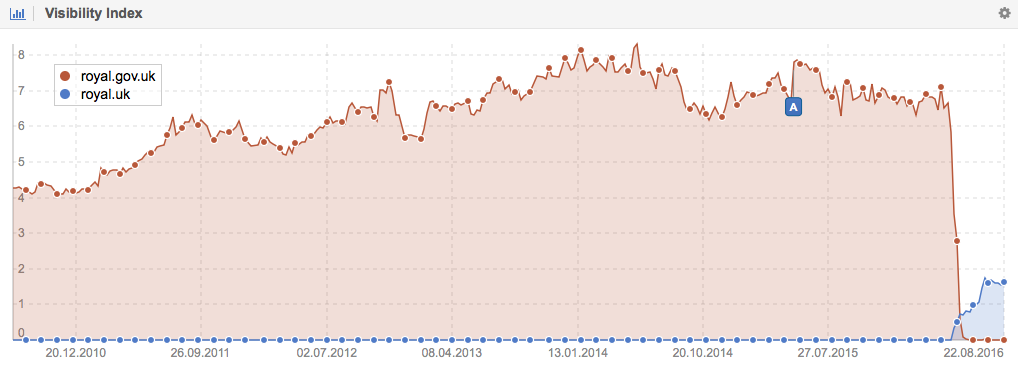
The Monarchs lost 75% of their Visibility on Google. You can go here and click on the “Check Availability” button to check the status codes for the best linked URLs of royal.gov.uk – if you want to look at the pages in your browser, simply click on the square with the arrow in front of the URL.
Mayor of London
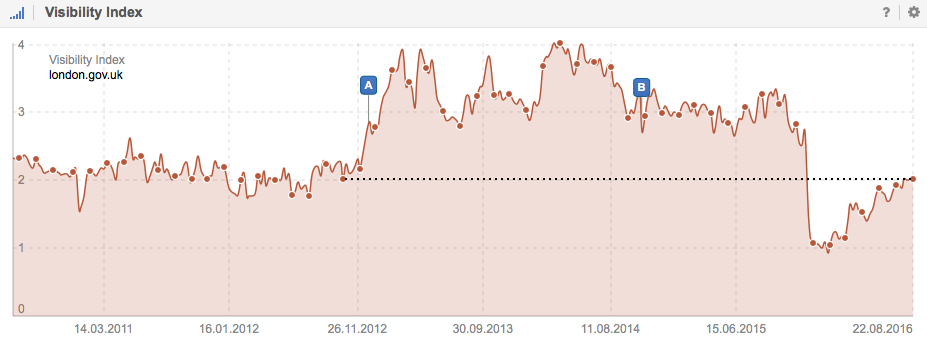
The website London.gov.uk received a redesign in December 2015, when Boris Johnson was still the Mayor of London. This website actually shows 2 of 3 possible ingredients which like to cause a slump on Google, missing redirects and soft 404s:
– The old URL https://www.london.gov.uk/priorities/housing-land/increasing-housing-supply/affordable-homes-programme responds with a 404. Paradoxically, the content itself is alive and well, patiently awaiting visitors at https://www.london.gov.uk/what-we-do/housing-and-land/increasing-housing-supply/affordable-homes-and-national-affordable-homes.
– On the other hand, there are some pages that actually use 301 redirects to redirect the visitors to the category page instead of the individual article, thereby creating soft-404 errors. One such example is https://www.london.gov.uk/priorities/business-economy/vision-and-strategy/infrastructure-plan-2050
The third ingredient would be redirecting old URLs to the homepage, as Royal.uk did.
If you would like to verify it yourself, just check the availability of the best linked URLs. You will see a lot of red, generated by 404s, as well as some wrong 301 redirects.
Tesla
Another very common mistake with significant repercussions is changing the domain name and the architecture of the website simultaneously. This is doomed to fail. SEOs should decide on one of these changes and give Google enough time to notice and understand what has happened – around 3 months – and only implement the second change afterwards.
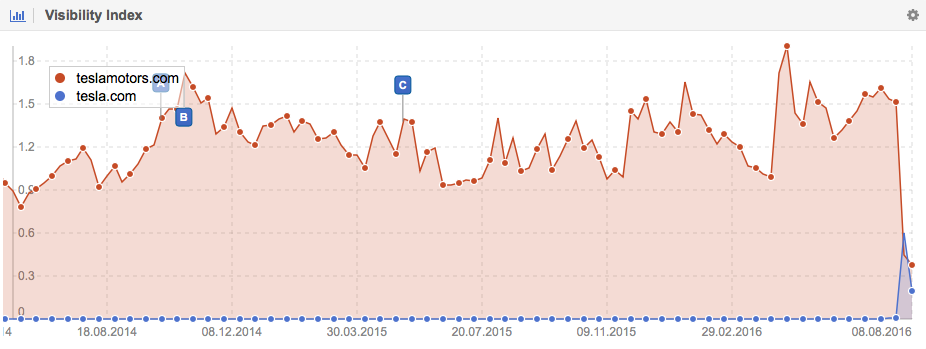
Teslamotors.com was ranking for 1,815 keywords before the domain move in July 2016. Now, Tesla.com is ranking for only 260 keywords, with none of them being in first position of the search results.
While Tesla.com also has other problems, I will not elaborate on them in this post.
Theguardian.com
The most popular case for this kind of Visibility loss due to a mix of changing the domain name and site architecture, like Tesla, could be observed with the move from Guardian.co.uk to Theguardian.com, 3 years ago. Here, we can actually see a three month delay (1) between the initial switch and Google fully crawling, processing and understanding the domain move. Even then, it took two years (2) before Theguardian.com managed to get back to the same level of Visibility within Google that they had for Guardian.co.uk.
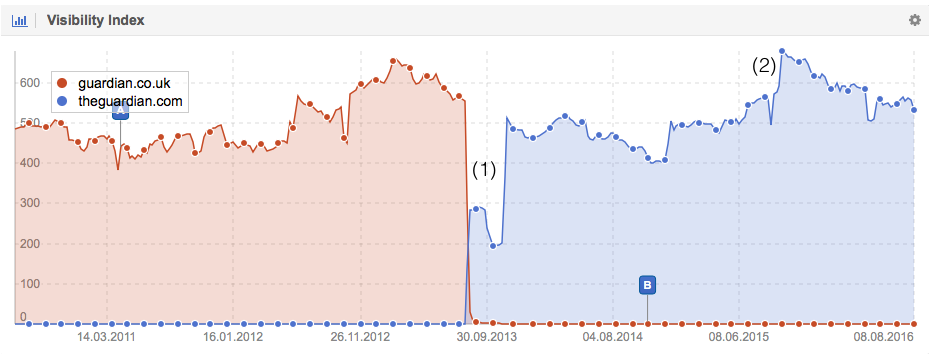
Fun fact: Guardian.co.uk still ranks for 3,225 keywords on Google, because some parts are still blocked by their robots.txt, which means Google will not access them and can therefore not notice the redirects on those pages.
H&M
This case is a combination of the Problems we see with Theguardian.com, London.gov.uk and Royal.co.uk. Where they changed the site architecture to move to a new hostname, www2.hm.com, kept their usual navigation almost intact but did not use the correct redirects. In this case it sadly even seems that these “choices” were made on purpose.
With the loss in Rankings for many generic keywords, the users are now forced to explicitly use the brand “h&m” within their searches. All in all, hm.com managed to lose both marketshare on Google and great opportunities. If we check out their Visibility history, we see that they have returned to the same level of Visibility they had almost 4 years ago:
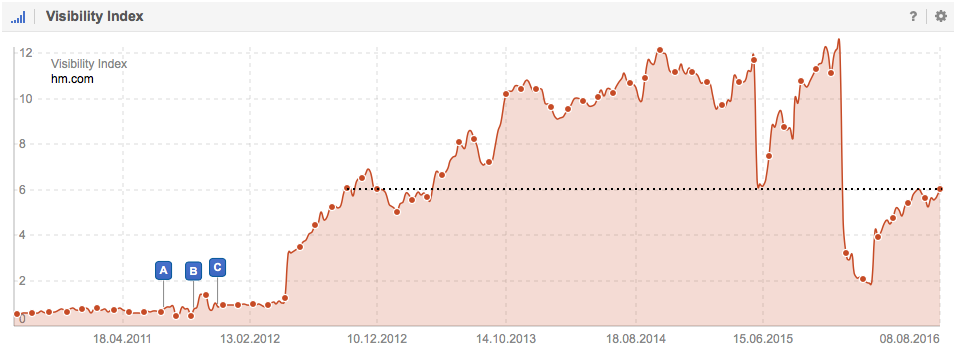
Manchester City F.C
Internal URLs provide the majority of all incoming links. As in the majority of cases, people will share your content and not you homepage. In the case of Mcfc.co.uk, 74.8% of all links (390,755 of 522,400) are deeplinks.
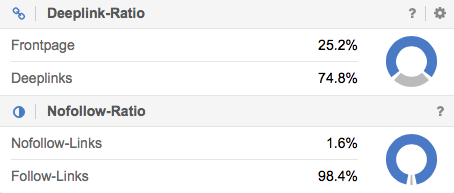
This means that, if you decide to either incorrectly redirect your old URLs or ignore redirects altogether, you will have to start from scratch on Google:
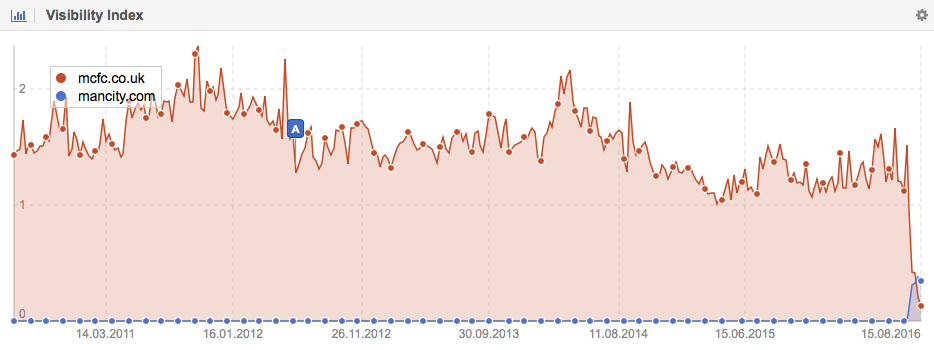
Does a domain move always have to be a problem?
No. A domain move is always risky and, in most cases, the domain will temporarily lose rankings and therefore SEO traffic. But I would like to show you a successful migration of a heavyweight.
On March 2016, the subdomain dictionary.reference.com was moved to the domain dictionary.com (!). It seems that during this move everything went smoothly and all bases were covered. So now, Dictionary.com sits at position number 8 of the top domains on Google.uk with 633 points of Visibility (right above BBC.co.uk) and at position number 5 of the top domains on Google US:
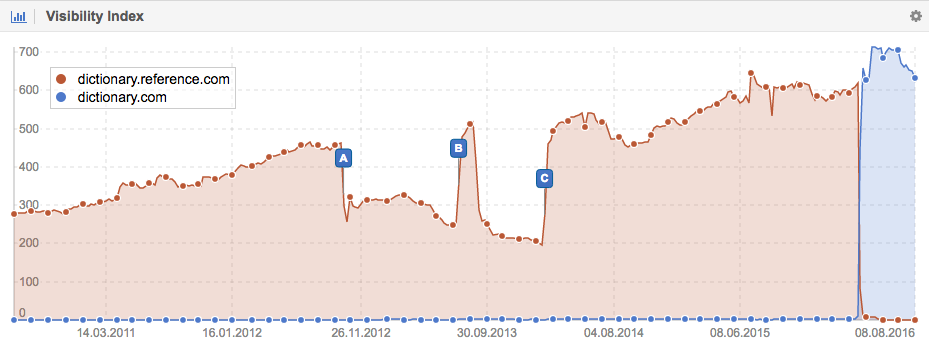
And while Reference.com has lost their most important asset, the dictionary, they are still growing and have a remarkable Visibility score of 48 points on Google UK and 36 on Google US.
Google is just another marketplace
It may be true that, when push comes to shove, the only performance indicators that count are economic KPIs and the money in the bank. Though, it is also true that indicators on the ranking development of a domain can give us an idea of where you stand. You can see if Google grants you more Visibility (marketshare) or less. You can evaluate SEO measures and figure out problems.
Another added value comes through the ability to run competitor analyses and compare them to your own domain. This is especially interesting as your own economic KPIs will not automatically translate into actionable information on your competition, and they are likely not that keen on sharing this information with you.
You are also able to figure out best-practice-examples outside of your own industry, which you can then adapt to leave your competitors in the dust: “don’t benchmark within your industry”.
In order to get a 360° view on your site and your industry, you need to analyse your own data and track your own rankings, in order to successfully increase your marketshare on Google and then use this marketshare to target profitable keywords (unless, of course, you are as unique as the Royals or Manchester City F.C).
If you only concentrate on one of these topics, you will likely miss important opportunities and potentials.
I hope you like it and I wish you a successful start to the week!
